Units, Scales and Coordinate Systems
Some images do not typically carry coordinate information; therefore, units, scales and pixel sizes of projects can be set manually in two ways:
- When you create a project, you can define the units in the Create Project dialog box (File > Create Project). When you specify a unit in your image analysis, eCognition Developer will always reference this value. For example, if you have an image of a land area with a scale of 15 pixels/km, enter 15 in the Pixel Size (Unit) box and select kilometer from the drop-down box below it. (You can also change the unit of an existing project by going to File > Modify Open Project.)
- During rule set execution with the Scene Properties algorithm. (See the Reference Book for more details.)
The default unit of a project with no resolution information is a pixel. For these projects, the pixel size cannot be altered. Once a unit is defined in a project, any number or features within a rule set can be used with a defined unit. Here the following rules apply:
- A feature can only have one unit within a rule set. The unit of the feature can be edited everywhere where the feature is listed, but always applies to every use of this feature – for example in rule sets, object information and classes
- All geometry-related features, such as ‘distance to’ let you specify units, for example pixels, metrics, or the ‘same as project unit’ value
- When using Object Features > Position, you can choose to display user coordinates (‘same as project unit’ or ‘coordinates’). Selecting ‘pixel’ uses the pixel (image) coordinate system.
- In Customized Arithmetic Features, the set calculation unit applies to numbers, not the used features. Be aware that customized arithmetic features cannot mix coordinate features with metric features – for example this feature would require two customized arithmetic features:
Since ‘same as project unit’ might vary with the project, we recommend using absolute units.
Thematic Layers and Thematic Objects
Thematic layers are raster or vector files that have associated attribute tables, which can add additional information to an image. For instance, a satellite image could be combined with a thematic layer that contains information on the addresses of buildings and street names. They are usually used to store and transfer results of an image analysis.
Thematic vector layers comprise only polygons, lines or points. While image layers contain continuous information, the information of thematic raster layers is discrete. Image layers and thematic layers must be treated differently in both segmentation and classification.
Importing, Editing and Deleting Thematic Layers
Typically – unless you have created them yourself – you will have acquired a thematic layer from an external source. It is then necessary to import this file into your project. eCognition Developer supports a range of thematic formats and a thematic layer can be added to a new project or used to modify an existing project.
Thematic layers can be specified when you create a new project via File > New Project – simply press the Insert button by the Thematic Layer pane. Alternatively, to import a layer into an existing project, use the File > Modify Existing Project function or select File > Add data Layer. Once defined, the Edit button allows you to further modify the thematic layer and the Delete button removes it.
When importing thematic layers, ensure the image layers and the thematic layers have the same coordinate systems and geocoding. If they do not, the content of the individual layers will not match.
As well as manually importing thematic layers, using the File > New Project or File > Modify Open Project dialog boxes, you can also import them using rule sets. For more details, look up the Create/Modify Project algorithm in the eCognition Developer Reference Book.
Importing Polygon Shapefiles
The polygon shapefile (.shp), which is a common format for geo-information systems, will import with its corresponding thematic attribute table file (.dbf) file automatically. For all other formats, the respective attribute table must be specifically indicated in the Load Attribute Table dialog box, which opens automatically. From the Load Attribute Table dialog box, choose one of the following supported formats:
- .txt (ASCII text files)
- .dbf (Dbase files)
- .csv (comma-separated values files)
When loading a thematic layer from a multi-layer image file (for example an .img stack file), the appropriate layer that corresponds with the thematic information is requested in the Import From Multi Layer Image dialog box. Additionally, the attribute table with the appropriate thematic information must be loaded.
If you import a thematic layer into your project and eCognition Developer does not find an appropriate column with the caption ID in the respective attribute table, the Select ID Column dialog box will open automatically. Select the caption of the column containing the polygon ID from the drop-down menu and confirm with OK.
Displaying a Thematic Layer
All thematic layers can be activated and inactivated for display via the Vector Layers checkbox, or individually using the respective checkbox of a single vector layer.
The Thematic Layer Attribute Table
The values of thematic objects are displayed in the Thematic Layer Attribute Table, which is launched via Tools > Thematic Layer Attribute Table.
To view the thematic attributes, open the Manual Editing toolbar. Choose Thematic Editing as the active editing mode and select a thematic layer from the Select Thematic Layer drop-down list.
The attributes of the selected thematic layer are now displayed in the Thematic Layer Attribute Table. They can be used as features in the same way as any other feature provided by eCognition.

The table supports integers, strings, and doubles. The column type is set automatically, according to the attribute, and table column widths can be up to 255 characters.
Class name and class color are available as features and can be added to the Thematic Layer Attribute Table window. You can modify the thematic layer attribute table by adding, editing or deleting table columns or editing table rows.
Manually Editing Thematic Vector Objects
A thematic object is the basic element of a thematic layer and can be a polygon, line or point. It represents positional data of a single object in the form of coordinates and describes the object by its attributes.
The Manual Editing toolbar lets you manage thematic objects, including defining regions of interest before image analysis and the verification of classifications after image analysis.
- To display the Manual Editing toolbar choose View > Toolbars > Manual Editing from the main menu
- For managing thematic objects, go to the Change Editing Mode drop-down menu and change the editing mode to Thematic Editing
- From the Select Thematic Layer drop-down menu select an existing thematic layer or create a new layer.
If you want to edit image objects instead of thematic objects by hand, choose Image Object Editing from the drop-down list.
Manual Editing Tools
While editing image objects manually is not commonly used in automated image analysis, it can be applied to highlight or reclassify certain objects, or to quickly improve the analysis result without adjusting a rule set. The primary manual editing tools are for merging, classifying and cutting manually.
To display the Manual Editing toolbar go to View > Toolbars > Manual Editing from the main menu. Ensure the editing mode, displayed in the Change Editing Mode drop-down list, is set to Image Object Editing.

If you want to edit thematic objects by hand, choose Thematic Editing from the drop-down list.
Creating a New Thematic Layer
If you do not use an existing layer to work with thematic objects, you can create a new one. For example, you may want to define regions of interest as thematic objects and export them for later use with the same or another project.
On the Select Thematic Layer drop-down menu, select New Layer to open the Create New Thematic Layer dialog box. Enter an name and select the type of thematic vector layer: polygon, line or point layer.
Generating Thematic Objects
There are two ways to generate new thematic objects – either use existing image objects or create them yourself. This may either be based on an existing layer or on a new thematic layer you have created.
For all objects, the selected thematic layer must be set to the appropriate selection: polygon, line or point. Pressing the Generate Thematic Objects button on the Manual Editing toolbar will then open the appropriate window for shape creation. The Single Selection button is used to finish the creation of objects and allows you to edit or delete them.
Creating Polygon Objects
To draw polygons go to the Change Editing Mode drop-down menu and change the editing mode to Thematic Editing. Now in the Select thematic layer drop-down select - New Layer -. In the upcoming dialog choose Type: Polygon Layer. Activate the Generate Thematic Objects button and click in the view to set vertices. Double click to complete the shape or right-click and select Close Polygon from the context menu. This object can touch or cross any existing image object.
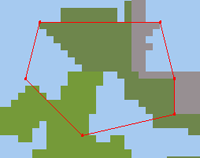
The following cursor actions are available:
- Click and hold the left mouse button as you drag the cursor across the map view to create a path with points
- To create points at closer intervals, drag the cursor more slowly or hold Ctrl while dragging
- Release the mouse button to automatically close the polygon
- Click along a path in the image to create points at each click. To close the polygon, double-click or select Close Polygon in the context menu
- To remove the last point before the polygon is complete, select Delete Last Point in the context menu.
Creating Lines and Points
To draw lines go to the Change Editing Mode drop-down menu and change the editing mode to Thematic Editing. Now in the Select thematic layer drop-down select - New Layer -. In the upcoming dialog choose Type: Line Layer. Activate the Generate Thematic Objects button and click in the view to set vertices in the thematic line layer. Double click to complete the line or right-click and choose End Line to stop drawing. This object can touch or cross any existing image object.
To generate points select thematic layer type: Point Layer and add points in one of the following ways:
- Click in the thematic layer. The point’s coordinates are displayed in the Generate Point window.
- Enter the point’s x- and y- coordinates in the Generate Point dialog box and click Add Point to generate the point.
The point objects can touch any existing image object. To delete the point whose coordinates are displayed in the Generate Point dialog box, press Delete Point.
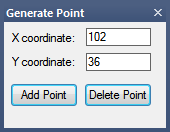
Generating Thematic Objects from Image Objects
Note that image objects can be converted to thematic objects automatically using the algorithm convert image objects to vector objects.
Thematic objects can be created manually from the outlines of selected image objects. This function can be used to improve a thematic layer – new thematic objects are added to the Thematic Layer Attribute Table. Their attributes are initially set to zero.
- Select a polygon layer for thematic editing. If a polygon layer does not exist in your map, create a new thematic polygon layer.
- Activate the Generate Thematic Object Based on Image Object button on the Manual Editing toolbar.
- In the map view, select an image object and right-click it. From the context menu, choose Generate Polygon to add the new object to the thematic layer
- To delete thematic objects, select them in the map view and click the Delete Selected Thematic Objects button
Use the Classify Selection context menu command if you want to classify image objects manually. Note, that you have to Select a Class for Manual Classification with activated Image object editing mode beforehand.
Selecting Thematic Objects Manually

Image objects or thematic objects can be selected using these buttons on the Manual Editing toolbar. From left to right:
- Single Selection Mode selects one object with a single click.
- Polygon Selection selects all objects that are located within the border of a polygon. Click in the map view to set each vertex of the polygon with a single click. To close an open polygon, right-click and choose Close Polygon. By default, all objects that touch the selection polygon outline are included. Again, if you only want objects within the selection, change the corresponding setting in Options.
- Line Selection selects all objects along a line. A line can also be closed to form a polygon by right-clicking and choosing Close Polygon . All objects touching the line are selected.
- Rectangle Selection selects all objects within a rectangle that you drag in the map view. By default, all objects that touch the selection polygon outline are included. If you want to only include objects that are completely within the selection polygon, change the corresponding setting in the Options dialog box.
Merging Thematic Objects Manually
You can merge objects manually, although this function only operates on the current image object level. To merge neighboring objects into a new single object, choose Tools > Manual Editing > Merge Objects from the main menu or press the Merge Objects Manually button on the Manual Editing toolbar to activate the input mode.
Select the neighboring objects to be merged in map view. Selected objects are displayed with a red outline (the color can be changed in View > Display Mode > Edit Highlight Colors).

To clear a selection, click the Clear Selection for Manual Object Merging button or deselect individual objects with a single mouse-click. To combine objects, use the Merge Selected Objects button on the Manual Editing toolbar, or right-click and choose Merge Selection.
If an object cannot be activated, it cannot be merged with the already selected one because they do not share a common border. In addition, due to the hierarchical organization of the image objects, an object cannot have two superobjects. This limits the possibilities for manual object merging, because two neighboring objects cannot be merged if they belong to two different superobjects.
Merging Thematic Objects Based on Image Objects
You can create merge the outlines of a thematic object and an image object while leaving the image object unchanged:
- Press the Merge Thematic Object Based on Image Object button
- Select a thematic object, and then an adjoining image object
- Right-click and choose Merge to Polygon.

Cutting a Thematic Object Manually
To cut a single image object or thematic object:
- Activate the manual cutting input mode by selecting Tools > Manual Editing > Cut Objects from the main menu
- To cut an object, activate the object to be split by clicking it
- Draw the cut line, which can consist of several sections. Depending on the object’s shape, the cut line can touch or cross the object’s outline several times, and two or more new objects will be created
- Right-click and select Perform Split to cut the object, or Close and Split to close the cut line before cutting
- The small drop-down menu displaying a numerical value is the Snapping Tolerance, which is set in pixels. When using Manual Cutting, snapping attracts object borders ‘magnetically’.
If you cut image objects, note that the Cut Objects Manually tool cuts both the selected image object and its sub-objects on lower image object levels.
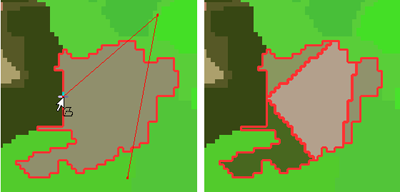
Saving Thematic Objects to a Thematic Layer
Thematic objects, with their accompanying thematic layers, can be exported to vector shapefiles. This enables them to be used with other maps or projects.
In the manual editing toolbar, select Save Thematic Layer As, which exports the layer in .shp format. Alternatively, you can use the Export Results dialog box.
Using a Thematic Layer for Segmentation
In contrast to image layers, thematic layers contain discrete information. This means that related layer values can carry additional information, defined in an attribute list.
The affiliation of an object to a class in a thematic layer is clearly defined, it is not possible to create image objects that belong to different thematic classes. To ensure this, the borders separating different thematic classes restrict further segmentation whenever a thematic layer is used during segmentation. For this reason, thematic layers cannot be given different weights, but can merely be selected for use or not.
If you want to produce image objects based exclusively on thematic layer information, you have to switch the weights of all image layers to zero. You can also segment an image using more than one thematic layer. The results are image objects representing proper intersections between the layers.
- To perform a segmentation using thematic layers, choose one of the following segmentation types from the Algorithms drop-down list of the Edit Process dialog box:
- Multiresolution segmentation
- Spectral difference segmentation
- Multiresolution segmentation region grow
- In the Algorithm parameters area, expand the Thematic Layer usage list and select the thematic layers to be considered in the segmentation. You can use the following methods:
- Select an thematic layer and click the drop-down arrow button placed inside the value field. Define for each the usage by selecting Yes or No
- Select Thematic Layer usage and click the ellipsis button placed inside the value field to set weights for image layers.
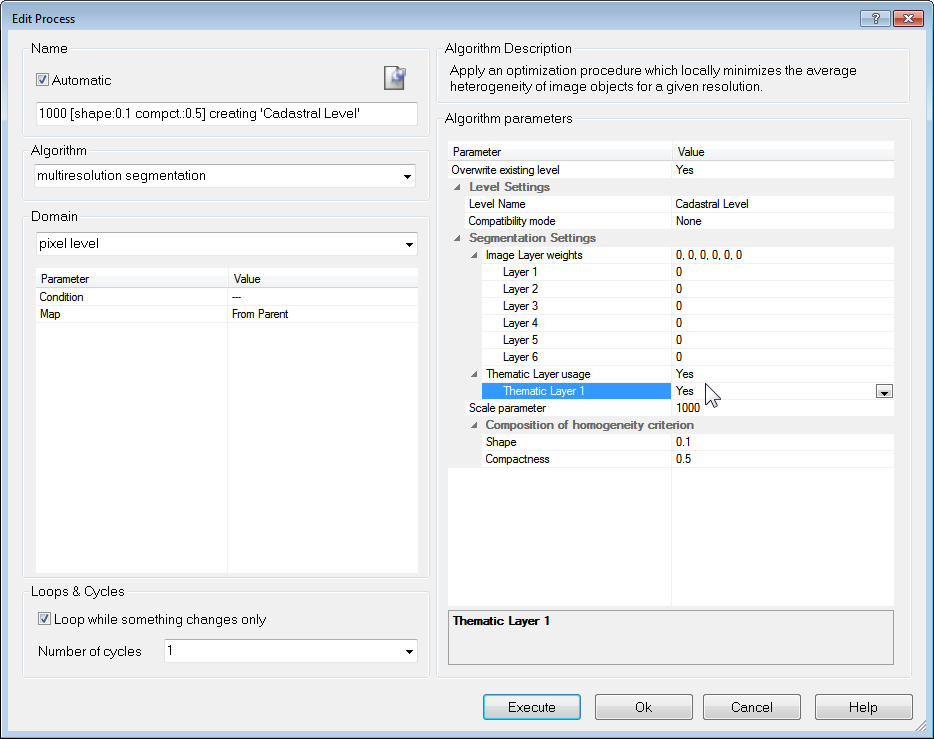
Variables in Rule Sets
Within rule sets you can use variables in different ways. Some common uses of variables are:
- Constants
- Fixed and dynamic thresholds
- Receptacles for measurements
- Counters
- Containers for storing temporary or final results
- Abstract placeholders that stand for a class, feature, or image object level.
While developing rule sets, you commonly use scene and object variables for storing your dedicated fine-tuning tools for reuse within similar projects.
Variables for classes, image object levels, features, image layers, thematic layers, maps and regions enable you to write rule sets in a more abstract form. You can create rule sets that are independent of specific class names or image object level names, feature types, and so on.
Related to Video - Startrails (customized import - layer arrays & variables - loops - layer arithmetics - update view)
About Variables
Scene Variables
Scene variables are global variables that exist only once within a project. They are independent of the current image object.
Object Variables
Object variables are local variables that may exist separately for each image object. You can use object variables to attach specific values to image objects.
Class Variables
Class Variables use classes as values. In a rule set they can be used instead of ordinary classes to which they point.
Feature Variables
Feature Variables have features as their values and return the same values as the feature to which they point.
Level Variables
Level Variables have image object levels as their values. Level variables can be used in processes as pointers to image object levels.
Image Layer and Thematic Layer Variables
Image Layer and Thematic Layer Variables have layers as their values. They can be selected whenever layers can be selected, for example, in features, domains, and algorithms. They can be passed as parameters in customized algorithms.
Region Variables
Region Variables have regions as their values. They can be selected whenever layers can be selected, for example in features, domains and algorithms. They can be passed as parameters in customized algorithms.
Map Variables
Map Variables have maps as their values. They can be selected wherever a map is selected, for example, in features, domains, and algorithm parameters. They can be passed as parameters in customized algorithms.
Feature List Variables
Feature List lets you select which features are exported as statistics.
Image Object List Variables
The Image Object List lets you organize image objects into lists and apply functions to these lists.
Creating a Variable
To open the Manage Variables box, go to the main menu and select Process > Manage Variables, or click the Manage Variables icon on the Tools toolbar.
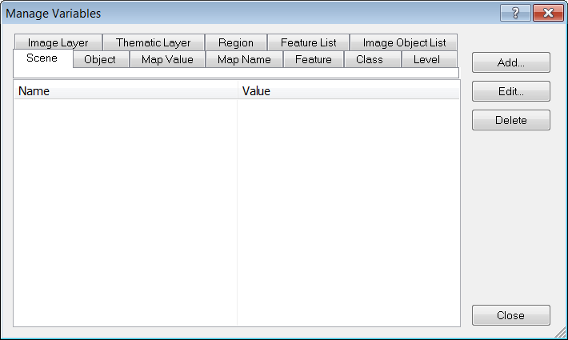
Select the tab for the type of variable you want to create then click Add. A Create Variable dialog box opens, with particular fields depending on which variable is selected.
Creating a Scene or Object Variable
Selecting scene or object variables launches the same Create Variable dialog box.
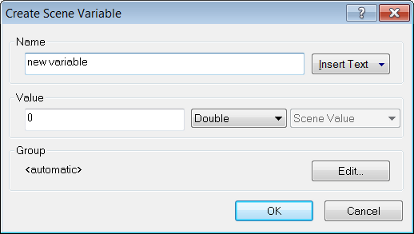
The Name and Value fields allow you to create a name and an initial value for the variable. In addition you can choose whether the new variable is numeric (double) or textual (string).
The Insert Text drop-down box lets you add patterns for rule set objects, allowing you to assign more meaningful names to variables, which reflect the names of the classes and layers involved. The following feature values are available: class name; image layer name; thematic layer name; variable value; variable name; level name; feature value.
The Type field is unavailable for both variables. The Shared check-box allows you to share the new variable among different rule sets.
Creating a Class Variable
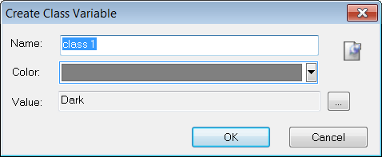
The Name field and comments button are both editable and you can also manually assign a color.
To give the new variable a value, click the ellipsis button to select one of the existing classes as the value for the class variable. Click OK to save the changes and return to the Manage Variables dialog box. The new class variable will now be visible in the Feature Tree and the Class Hierarchy, as well as the Manage Variables box.
Creating a Feature Variable
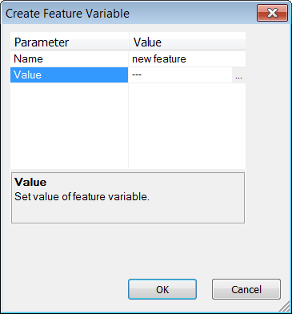
After assigning a name to your variable, click the ellipsis button in the Value field to open the Select Single Feature dialog box and select a feature as a value.
After you confirm the variable with OK, the new variable displays in the Manage Variables dialog box and under Feature Variables in the feature tree in several locations, for example, the Feature View window and the Select Displayed Features dialog box
Creating a Region Variable
Region Variables have regions as their values and can be created in the Create Region Variable dialog box. You can enter up to three spatial dimensions and a time dimension. The left hand column lets you specify a region’s origin in space and the right hand column its size.
The new variable displays in the Manage Variables dialog box, and wherever it can be used, for example, as a domain parameter in the Edit Process dialog box.
Creating Other Types of Variables
Create Level Variable allows the creation of variables for image object levels, image layers, thematic layers, maps or regions.
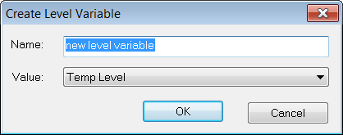
The Value drop-down box allows you to select an existing level or leave the level variable unassigned. If it is unassigned, you can use the drop-down arrow in the Value field of the Manage Variables dialog box to create one or more new names.
Saving Variables as Parameter Sets
Parameter sets are storage containers for specific variable value settings. They are mainly used when creating action libraries, where they act as a transfer device between the values set by the action library user and the rule set behind the action. Parameter sets can be created, edited, saved and loaded. When they are saved, they store the values of their variables; these values are then available when the parameter set is loaded again.
Creating a Parameter Set
To create a parameter set, go to Process > Manage Parameter Sets

In the dialog box click Add. The Select Variable for Parameter Set dialog box opens. After adding the variables the Edit Parameter Set dialog box opens with the selected variables displayed.

Insert a name for your new parameter set and confirm with OK.
Editing a Parameter Set
You can edit a parameter set by selecting Edit in the Manage Parameter Sets dialog box:
- To add a variable to the parameter set, click Add Variable. The Select Variable for Parameter Set dialog box opens
- To edit a variable select it and click Edit. The Edit Value dialog box opens where you can change the value of the variable
- If you select a feature variable, the Select Single Feature dialog opens, enabling you to select another value
- If you select a class variable, the Select Class dialog opens, enabling you to select another value
- If you select a level variable, the Select Level dialog opens, enabling you to select another value
- To delete a variable from the parameter set, select it and click Delete
- Click Update to modify the value of the selected variable according to the value of the rule set
- Click Apply to modify the value of the variable in the rule set according to the value of the selected variable
- To change the name of the parameter set, type in a new name.
Actions #4 and #5 may change your rule set.
Managing Parameter Sets
- To delete a parameter set, select it and press Delete
- To save a parameter set to a .psf file, select it and click Save
- Click Save All when you want to save all parameter sets to one .psf file
- Click Load to open existing parameter sets
- Click Update to modify the values of the variables in the parameter set according to the values of the rule set
- Click Apply to modify the values of the variables in the rule set according to the values of the parameter set.
Arrays
The array functions in eCognition Developer let you create lists of features, which are accessible from all rule set levels. This allows rule sets to be repeatedly executed across, for example, classes, levels and maps.
Related to Video - Startrails (customized import - layer arrays & variables - loops - layer arithmetics - update view)
Creating Arrays
The Manage Arrays dialog box can be accessed via Process > Manage Arrays in the main menu. The following types of arrays are supported: numbers; strings; classes; image layers; thematic layers; levels; features; regions; map names.
To add an array, press the Add Array button and select the array type from the drop-down list. Where arrays require numerical values, multiple values must be entered individually by row. Using this dialog, array values – made up of numbers and strings – can be repeated several times; other values can only be used once in an array. Additional values can be added using the algorithm Update Array, which allows duplication of all array types.
When selecting arrays such as level and image layer, hold down the Ctrl or Shift key to enter more than one value. Values can be edited either by double-clicking them or by using the Edit Values button.

Order of Array Items
Initially, string, double, map and region arrays are executed in the order they are entered. However, the action of rule sets may cause this order to change.
Class and feature arrays are run in the order of the elements in the Class Hierarchy and Feature Tree. Again, this order may be changed by the actions of rule sets; for example a class or feature array may be sorted by the algorithm Update Array, then the array edited in the Manage Array dialog at a later stage – this will cause the order to be reset and duplicates to be removed.
Using Arrays in Rule Sets
From the Domain
‘Array’ can be selected in all Process-Related Operations (other than Execute Child Series).
From Variables and Values
In any algorithm where it is possible to enter a value or variable parameter, it is possible to select an array item.
Array Features
In Scene Features > Rule set-related, three array variables are present: rule set array values, rule set array size and rule set array item. For more information, please consult the Reference Book.
In Customized Algorithms
Rule set arrays may be used as parameters in customized algorithms.
In Find and Replace
Arrays may be selected in the Find What box in the Find and Replace pane.
Image Objects and Their Relationships
Implementing Child Domains via the Execute Child Process Algorithm
Through the examples in earlier chapters, you will already have some familiarity with the idea of parent and child domains, which were used to organize processes in the Process Tree. In that example, a parent object was created which utilized the Execute Child Processes algorithm on the child processes beneath it.
- The child processes within these parents typically defined algorithms at the image object level. However, depending on your selection, eCognition Developer can apply algorithms to other objects selected from the Domain.
- Current image object: The parent image object itself.
- Neighbor obj: The distance of neighbor objects to the parent image object. If distance is zero, this refers to image objects that have a common border with the parent and lie on the same image object level. If a value is specified, it refers to the distance between an object’s center of mass and the parent’s center of mass, up to that specified threshold
- Sub objects: Objects whose image area covers all or part of the parent’s image area and lie a specified number of image object levels below the parent’s image object level.
- Super objects: Objects whose image area covers some or all of the parent’s image area and lie a specified number of image object levels above the parent’s image object level. (Note that the child image object is on top here.)
Child Domains and Parent Processes
Terminology
Below is a list of terms used in the context of process hierarchy
- Parent process: A parent process is used for grouping child processes together in a process hierarchy.
- Child process: A child process is inserted on a level beneath a parent process in the hierarchy.
- Child domain / subdomain: A domain defined by using one of the four local processing options.
- Parent process object (PPO): A parent process object (PPO) is the object defined in the parent process.
Parent Process Objects
A parent process object (PPO) is an image object to which a child process refers and must first be defined in the parent process. An image object can be called through the respective selection in the Edit Process dialog box; go to the Domain group box and select one of the four local processing options from the drop-down list, such as current image object.
When you use local processing, the routine goes to the first random image object described in the parent domain and processes all child processes defined under the parent process, where the PPO is always that same image object.
The routine then moves through every image object in the parent domain. The routine does not update the parent domain after each processing step; it will continue to process those image objects found to fit the parent process’s domain criteria, no matter if they still fit them when they are to be executed.
A special case of a PPO is the 0th order PPO, also referred to as PPO(0). Here the PPO is the image object defined in the domain in the same line (0 lines above).
For better understanding of child domains (subdomains) and PPOs, see the example below.
Using Parent Process Objects for Local Processing
This example demonstrates how local processing is used to change the order in which class or feature filters are applied. During execution of each process line, eCognition software first creates internally a list of image objects that are defined in the domain. Then the desired routine is executed for all image objects on the list.
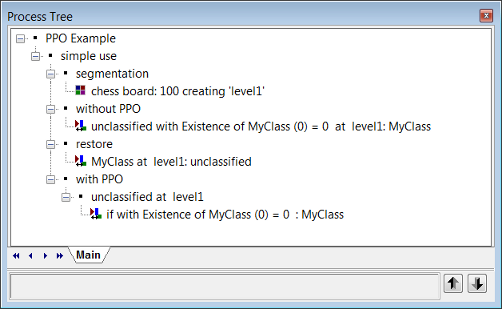
ParentProcessObjects.dpr

- Have a look at the screenshot of the rule set of this project.
- Using the parent process named ‘simple use’ you can compare the results of the Assign Class algorithm with and without the parent process object (PPO).
- At first a segmentation process is executed.
- Then the ‘without PPO’ process using the Assign Class algorithm is applied. Without a PPO the whole image is classified. This is because, before processing the line, no objects of class My Class existed, so all objects in Level 1 return true for the condition that no My Class objects exist in the neighborhood. In the next example, the two process steps defining the domain objects on Level 1 and
no My Classobjects exist in the neighborhood are split into two different lines. - Executing the process
at Level 1: Unclassified (restore)removes the classification and returns to the state after step 3. - The the process ‘with PPO’ is executed.
The process if with Existence of My Class (0) = 0:My Class applies the algorithm Assign Class to the image object that has been set in the parent process unclassified at Level 1: for all. This has been invoked by selecting Current Image Object as domain. Therefore, all unclassified image objects will be called sequentially and each unclassified image object will be treated separately.
- Executing the process results is a painted chessboard.
- At first, all objects on image object Level 1 are put in a list. The process does nothing but pass on the identities of each of those image objects down to the next line, one by one. That second line – the child process – has only one object in the domain, the current image object passed down from the parent process. It then checks the feature condition, which returns true for the first object tested. But the next time this process is run with the next image object, that image object is tested again and returns false for the same feature, because now the object has the first object as a My Class neighbor.
- To summarize – in the example ‘without PPO’, all image objects that fitted the condition were classified at once; in the second example’with PPO’, a list of 48 image objects is created in the upper process line, and then the child process runs 48 times and checks if the condition is fullfilled or not.
- In other words – the result with the usage of the parent process object (PPO) is totally different than without using it. Algorithms that are referring to a parent process object (PPO), must be executed from the parent process. Therefore, you must execute the parent process itself or in between a superordinated parent process. The case is that using the parent process object (PPO) will process each image object in the image in succession. That means: the algorithm checks for the first unclassified image object complying with the set condition which is ‘Existence of My Class (0) = 0)’. The image object identifies that there is no My Class neighbor, so it classifies itself to My Class. Then the algorithm goes to the second unclassified image object and finds a neighbor, which means the condition does not fit. Then it goes to the third, there is no neighbor, so it classifies itself, and so on.
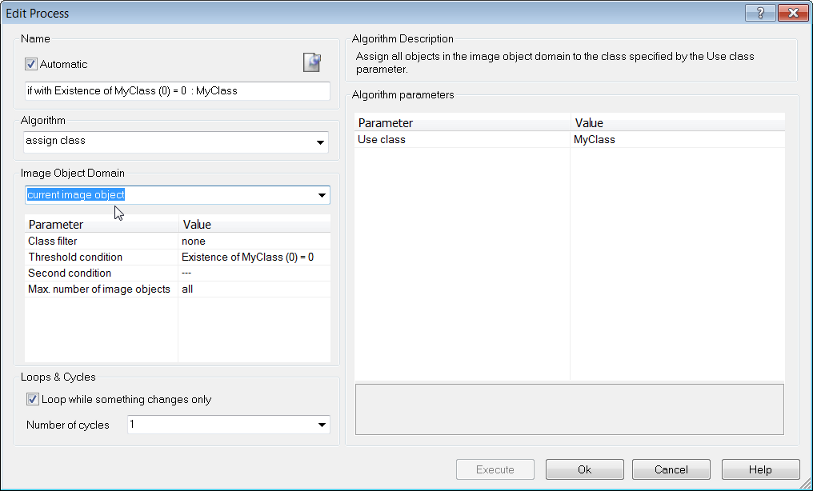

Example: Using Process-Related Features for Advanced Local Processing
One more powerful tool comes with local processing. When a child process is executed, the image objects in the domain ‘know’ their parent process object (PPO). It can be very useful to directly compare properties of those image objects with the properties of the PPO. A special group of features, the process-related features, do exactly this job.
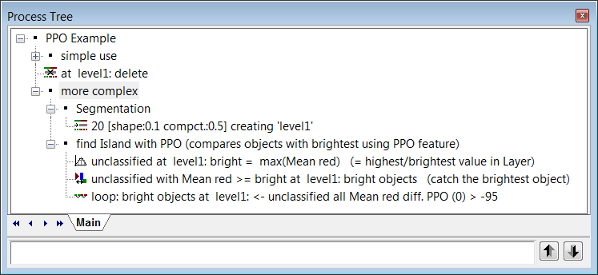
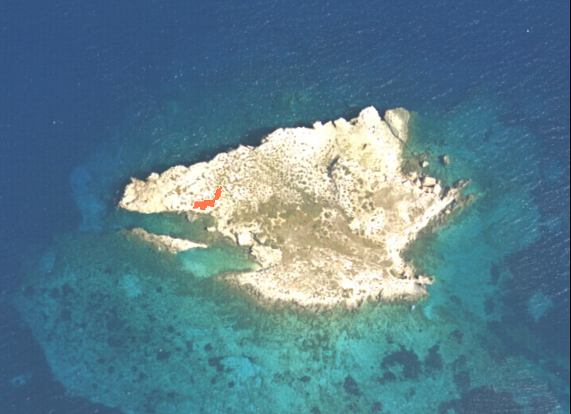
- In this example each child process from the process
more complexis executed. After the Segmentation the visualization settings are switched to the outline view. In this rule set the PPO(0) procedure is used to merge the image objects with the brightest image object classified asbright objectsin the red image layer. For this purpose a difference range (> −95) to an image object of the classbright objectsis used. - The red image object (
bright objects) is the brightest image object in this image. To find out how it is different from similar image objects to be merged with, the user has to select it using the Ctrl key. Doing that the parent process object (PPO) is manually selected. The PPO will be highlighted in green. - For better visualization the outlines can now be switched off and using the Feature View window the feature Mean red diff. PPO (0) can be applied. To find the best-fitting range for the difference to the brightest object (
bright objects) the values in the Object Information window can be checked.
The green highlighted image object displays the PPO. All other image objects that are selected will be highlighted in red and you can view the difference from the green highlighted image object in the Object Information window . Now you can see the result of the image object fusion.
- Typically, you create the process-related features you need for your specific rule set. For features that set an image object in relation to the parent object only an integer number has to be specified, the process distance (Dist.) It refers to the distance in the process hierarchy; the number of hierarchy levels in the Process Tree window above the current editing line, in which you find the definition of the parent object. This is true for the following features:
- Same super object as PPO
- Elliptic Distance from PPO
- Rel. border to PPO
- Border to PPO
For the following process-related features, comparing an image object to the parent object the process distance (Dist.) has to be specified as well: - Ratio PPO
- Diff PPO
In addition, you have to select the feature that you want to be compared. For example, if you create a new ratio PPO, select Distance=2 and the feature Area; the created feature will be Area ratio PPO (2). The number it returns will be the area of the object in question divided by the area of the parent process object of order 2, that is the image object whose identity was handed down from two lines above in the process tree.
A special case are process-related features with process Distance=0, called PPO(0) features. They only make sense in processes that need more than one image object as an input, for example image object fusion. You may have a PPO(0) feature evaluated for the candidate or for the target image object. That feature is then compared or set to relation to the image object in the domain of the same line, that is the seed image object of the image object fusion.
Go to the Feature View window to create a process-related feature sometimes referred to as PPO feature. Expand the process-related features group.
To create a process-related feature (PPO feature), double-click on the feature you want to create and add a process distance to the parent process object. The process distance is a hierarchical distance in the process tree, for example: - PPO(0), has the process distance 0, which refers to the image object in the current process, that is mostly used in the image object fusion algorithm.
- PPO(1), has the process distance 1, which refers to the image object in the parent process one process hierarchy level above.
- PPO(2), has the process distance 2, which refers to the parent process two hierarchy levels above in the process hierarchy.
If you want to create a customized parent process object, you also have to choose a feature.
- The following processes in the sample rule set are using different parent process object hierarchies. Applying them is the same procedure as shown before with the PPO(0).
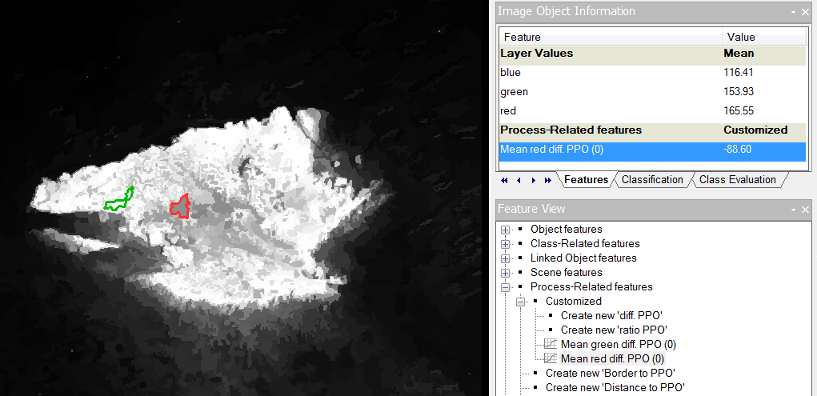

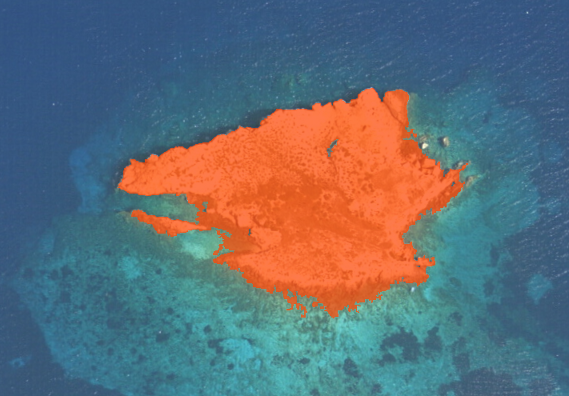
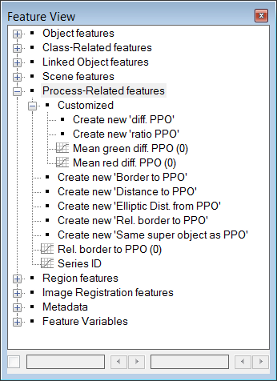
Customized Features
Customized features can be arithmetic or relational (relational features depend on other features). All customized features are based on the features of eCognition Developer.
- Arithmetic features are composed of existing features, variables, and constants, which are combined via arithmetic operations. Arithmetic features can be composed of multiple features
- Relational features, are used to compare a particular feature of one object to those of related objects of a specific class within a specified distance. Related objects are surrounding objects such as neighbors, sub-objects, superobjects, sub-objects of a superobject or a complete image object level. Relational features are composed of only a single feature but refer to a group of related objects.
Creating Customized Features
The Manage Customized Features dialog box allows you to add, edit, copy and delete customized features, and to create new arithmetic and relational features based on the existing ones.
To open the dialog box, click on Tools > Manage Customized Features from the main menu, or click the icon on the Tools toolbar.
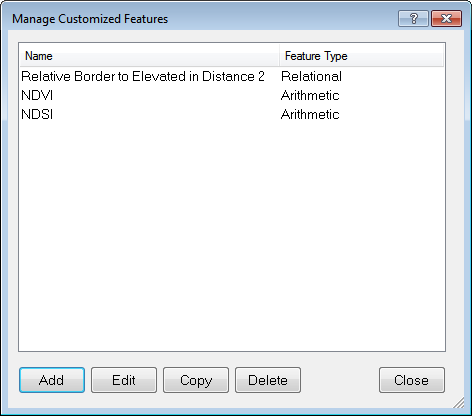
Clicking the Add button launches the Customized Features dialog box, which allows you to create a new feature. The remaining buttons let you to edit, copy and delete features.
Arithmetic Customized Features
The procedure below guides you through the steps you need to follow when you want to create an arithmetic customized feature.
Open the Manage Customized Features dialog box and click Add. Select the Arithmetic tab in the Customized Features dialog box.
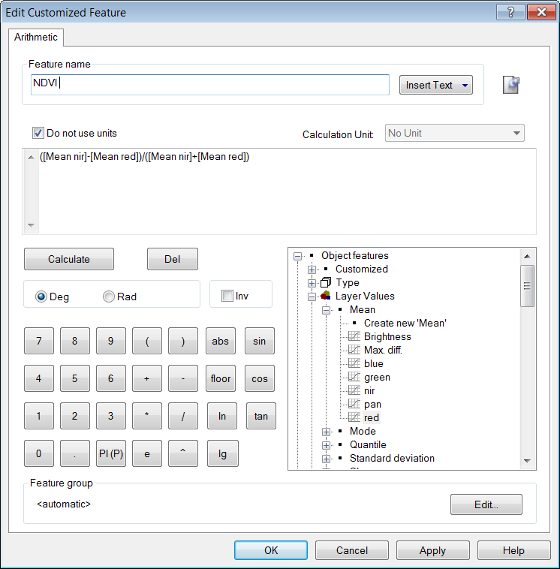
- Insert a name for the customized feature and click on the map-pin icon to add any comments if necessary
- The Insert Text drop-down box lets you add patterns for rule set objects, allowing you to assign more meaningful names to customized features, which reflect the names of the classes and layers involved. The following feature values are available: class name; image layer name; thematic layer name; variable value; variable name; level name; feature value. Selecting <automatic> displays the arithmetic expression itself
- Use the calculator to create the arithmetic expression. You can:
- Type in new constants
- Select features or variables in the feature tree on the right
- Choose arithmetic operations or mathematical functions
- To calculate or delete an arithmetic expression, highlight the expression with the cursor and then click either Calculate or Del.
- You can switch between degrees (Deg) or radians (Rad)
- Click the Inv check-box to invert the expression
- To create a new customized feature do one of the following:
- Click Apply to create the feature without leaving the dialog box
- Click OK to create the feature and close the dialog box.
- After creation, the new arithmetic feature can be found in:
- The Object Information window
- The Feature View window under Object Features > Customized.
The calculator buttons are arranged in a standard layout. In addition:
- ^ signifies an exponent (for example, x^2 means
) or a square root (x^0.5 for
).
- Use abs for an absolute value
- Use floor to round down to the next lowest integer (whole value). You can use floor(0.5 + x) to round up to the next integer value.
- Note that e is the Euler number and PI (P) is
.
Relational Customized Features
The following procedure will assist you with the creation of a relational customized feature.
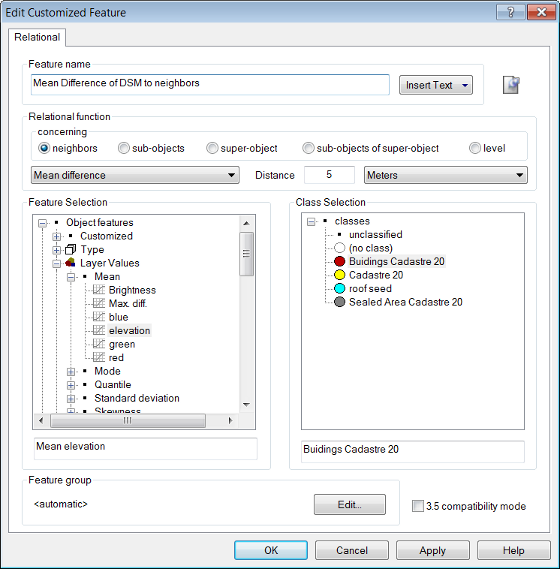
- Open the Manage Customized Features dialog box (Tools > Manage Customized Features) and click Add. The Customized Features dialog opens; select the Relational tab
- The Insert Text drop-down box lets you add patterns for rule set objects, allowing you to assign more meaningful names to customized features, which reflect the names of the classes and layers involved. The following feature values are available: class name; image layer name; thematic layer name; variable value; variable name; level name; feature value
- Insert a name for the relational feature to be created1
- Select the target for the relational function the ‘concerning’ area
- Choose the relational function to be applied in the drop-down box
- Define the distance of the related image objects. Depending on the related image objects, the distance can be either horizontal (expressed as a unit) or vertical (image object levels)
- Select the feature for which to compute the relation
- Select a class, group or ‘no class’ to apply the relation.
- Click Apply to create the feature without leaving the dialog box or click OK to create it close the dialog box.
- After creation, the new relational feature will be listed in the Feature View window under Class-Related Features > Customized.
Relations between surrounding objects can exist either on the same level or on a level lower or higher in the image object hierarchy:
| Object | Description |
|---|---|
| Neighbors | Related image objects on the same level. If the distance of the image objects is set to 0 then only the direct neighbors are considered. When the distance is greater than 0 then the relation of the objects is computed using their centers of gravity. Only those neighbors whose center of gravity is closer than the distance specified from the starting image object are considered. The distance is calculated either in definable units or pixels. |
| Sub-objects | Image objects that exist below other image objects whose position in the hierarchy is higher (super-objects). The distance is calculated in levels. |
| Super-object | Contains other image objects (sub-objects) on lower levels in the hierarchy. The distance is calculated in levels. |
| Sub-objects of super-object | Only the image objects that exist below a specific superobject are considered in this case. The distance is calculated in levels. |
| Level | Specifies the level on which an image object will be compared to all other image objects existing at this level. The distance is calculated in levels. |
Overview of all functions existing in the drop-down list under the relational function section:
| Function | Description |
|---|---|
| Mean | Calculates the mean value of selected features of an image object and its neighbors. You can select a class to apply this feature or no class if you want to apply it to all image objects. Note that for averaging, the feature values are weighted with the area of the image objects. |
| Standard deviation | Calculates the standard deviation of selected features of an image object and its neighbors. You can select a class to apply this feature or no class if you want to apply it to all image objects. |
| Mean difference | Calculates the mean difference between the feature value of an image object and its neighbors of a selected class. Note that the feature values are weighted by either by the border length (distance =0) or by the area (distance >0) of the respective image objects. |
| Mean absolute difference | Calculates the mean absolute difference between the feature value of an image object and its neighbors of a selected class. Note that the feature values are weighted by either by the border length (distance =0) or by the area (distance >0)of the respective image objects. |
| Ratio | Calculates the proportion between the feature value of an image object and the mean feature value of its neighbors of a selected class. Note that for averaging the feature values are weighted with the area of the corresponding image objects. |
| Sum | Calculates the sum of the feature values of the neighbors of a selected class. |
| Number | Calculates the number of neighbors of a selected class. You must select a feature in order for this feature to apply, but it does not matter which feature you pick. |
| Min | Returns the minimum value of the feature values of an image object and its neighbors of a selected class. |
| Max | Returns the maximum value of the feature values of an image object and its neighbors of a selected class. |
| Mean difference to higher values | Calculates the mean difference between the feature value of an image object and the feature values of its neighbors of a selected class, which have higher values than the image object itself. Note that the feature values are weighted by either by the border length (distance =0) or by the area (distance > 0)of the respective image objects. |
| Mean difference to lower values | Calculates the mean difference between the feature value of an image object and the feature values of its neighbors of a selected class, which have lower values than the object itself. Note that the feature values are weighted by either by the border length (distance = 0) or by the area (distance >0) of the respective image objects. |
| Portion of higher value area | Calculates the portion of the area of the neighbors of a selected class, which have higher values for the specified feature than the object itself to the area of all neighbors of the selected class. |
| Portion of lower value area | Calculates the portion of the area of the neighbors of a selected class, which have lower values for the specified feature than the object itself to the area of all neighbors of the selected class. |
| Portion of higher values | Calculates the feature value difference between an image object and its neighbors of a selected class with higher feature values than the object itself divided by the difference of the image object and all its neighbors of the selected class. Note that the features are weighted with the area of the corresponding image objects. |
| Portion of lower values | Calculates the feature value difference between an image object and its neighbors of a selected class with lower feature values than the object itself divided by the difference of the image object and all its neighbors of the selected class. Note that the features are weighted with the area of the corresponding image object. |
| Mean absolute difference to neighbors | Available only if sub-objects is selected for Relational function concerning. Calculates the mean absolute difference between the feature value of sub-objects of an object and the feature values of a selected class. Note that the feature values are weighted by either by the border length (distance = 0) or by the area (distance > 0) of the respective image objects. |
Saving and Loading Customized Features
You can save customized features separately for use in other rule sets:2
- Open the Tools menu in the main menu bar and select Save Customized Features to open the Save Customized Features dialog box. Your customized features are saved as a .duf file.
- To load customized features that have been saved as a .duf file, open the Tools menu and select Load Customized Features to open the Load Customized Features dialog box.
Finding Customized Features
You can find customized features at different places in the feature tree, depending on the features to which they refer. For example, a customized feature that depends on an object feature is sorted below the group Object Features > Customized.
If a customized feature refers to different feature types, they are sorted in the feature tree according to the interdependencies of the features used. For example, a customized feature with an object feature and a class-related feature displays below class-related features.
Defining Feature Groups
You may wish to create a customized feature and display it in another part of the Feature Tree. To do this, go to Manage Customized Features and press Edit in the Feature Group pane. You can then select another group in which to display your customized feature. In addition, you can create your own group in the Feature Tree by selecting Create New Group. This may be useful when creating solutions for another user.
Although it is possible to use variables as part or all of a customized feature name, we would not recommend this practice as – in contrast to features – variables are not automatically updated and the results could be confusing.
Customized Algorithms
Defining customized algorithms is a method of reusing a process sequence in different rule sets and analysis contexts. By using customized algorithms, you can split complicated procedures into a set of simpler procedures to maintain rule sets over a longer period of time.
You can specify any rule set item (such as a class, feature or variable) of the selected process sequence to be used as a parameter within the customized algorithm. A creation of configurable and reuseable code components is thus possible. A rule set item is any object in a rule set. Therefore, a rule set item can be a class, feature, image layer alias, level name or any type of variable.
Customized algorithms can be modified, which ensures that code changes take effect immediately in all relevant places in your rule set. When you want to modify a duplicated process sequence, you need to perform the changes consistently to each instance of this process. Using customized algorithms, you only need to modify the customized algorithm and the changes will affect every instance of this algorithm.
A rule set item is any object in a rule set other than a number of a string. Therefore, a rule set item can be a class, feature, image layer alias, level name or any type of variable. To restrict the visibility and availability of rule set items to a customized algorithm, local variables or objects can be created within a customized algorithm. Alternatively, global variables and objects are available throughout the complete rule set.
A rule set item in a customized algorithm can belong to one of the following scope types:
- Local scope: Local rule set items are only visible within a customized algorithm and can only be used in child processes of the customized algorithm. For this scope type, a copy of the respective rule set item is created and placed in the local scope of the customized algorithm. Local rule set items are thus listed in the relevant controls (such as the Feature View or the Class Hierarchy), but they are only displayed when the customized algorithm is selected.
- Global scope: Global rule set items are available to all processes in the rule set. They are accessible from anywhere in the rule set and are especially useful for customized algorithms that are always used in the same environment, or that change the current status of variables of the main rule set. We do not recommend using global rule set items in a customized algorithm if the algorithm is going to be used in different rule sets.
- Parameter scope: Parameter rule set items are locally scoped variables in a customized algorithm. They are used like function parameters in programming languages. When you add a process including a customized algorithm to the Main tab of the Process Tree window, you can select the values for whatever parameters you have defined. During execution of this process, the selected values are assigned to the parameters. The process then executes the child processes of the customized algorithm using the selected parameter values.
Dependencies and Scope Consistency Rules
Rule set items can be grouped as follows, in terms of dependencies:
- Dependent: Dependent rule set items are used by other rule set items. For example, if class A uses the feature Area and the customized feature Arithmetic1 in its class description, it has two dependencies – Area and Arithmetic1
- Reference: Reference rule set items use other rule set items. For example, if the Area feature is used by class A and the customized feature by Arithmetic1, classA is its reference and and Arithmetic1 is a dependent.
A relationship exists between dependencies of rule set items used in customized algorithms and their scope. If, for example, a process uses class A with a customized feature Arithmetic1, which is defined as local within the customized algorithm, then class A should also be defined as local. Defining class A as global or parameter can result in an inconsistent situation (for example a global class using a local feature of the customized algorithm).
Scope dependencies of rule set items used in customized algorithms are handled automatically according to the following consistency rules:
- If a rule set item is defined as global, all its references and dependent must also be defined as global. If at least one dependent or referencing rule set item cannot be defined as global, this scope should not be used. An exception exists for features without dependents, such as area and other features without editable parameters. If these are defined as global, their references are not affected.
- If a rule set item is defined as local or as parameter, references and dependents also have to be defined as local. If at least one dependent or referencing rule set item cannot be defined as local, this scope should not be used. Again, features without dependents, such as area and other features without editable parameters, are excepted. These remain global, as it makes no sense to create a local copy of them.
Handling of References to Local Items During Runtime
During the execution of a customized algorithm, image objects can refer to local rule set items. This might be the case if, for example, they get classified using a local class, or if a local temporary image object level is created. After execution, the references have to be removed to preserve the consistency of the image object hierarchy. The application offers two options to handle this cleanup process.
When Delete Local Results is enabled, the software automatically deletes locally created image object levels, removes all classifications using local classes and removes all local image object variables. However, this process takes some time since all image objects need to be scanned and potentially modified. For customized algorithms that are called frequently or that do not create any references, this additional checking may cause a significant runtime overhead. If not necessary, we therefore do not recommend enabling this option.
When Delete Local Results is disabled, the application leaves local image object levels, classifications using local classes and local image object variables unchanged. Since these references are only accessible within the customized algorithm, the state of the image object hierarchy might then no longer be valid. When developing a customized algorithm you should therefore always add clean-up code at the end of the procedure, to ensure no local references are left after execution. Using this approach, you will create customized algorithms with a much better performance compared to algorithms that relying on the automatic clean-up capability.
Domain Handling in Customized Algorithms
When a customized algorithm is called, the selected domain needs to be handled correctly. There are two options:
- If the Invoke Algorithm for Each Object option is selected, the customized algorithm is called separately for each image object in the selected domain. This option is most useful if the customized algorithm is only called once using the Execute domain. You can also use the current domain within the customized algorithm to process the current image object of the calling process. However, in this case we recommend to pass the domain as a parameter
- The Pass Domain from Calling Process as a Parameter option offers two possibilities:
- If Object Set is selected, a list of objects is handed over to the customized algorithm and the objects can be reclassified or object variables can be changed. if a segmentation is performed on the objects, the list is destroyed since the objects are ‘destroyed’ with new segmentation
- If Domain Definition is selected, filter settings for objects are handed over to the customized algorithm. Whenever a process – segmentation, fusion or classification – is performed, all objects are checked to see if they still suit the filter settings
- If the Pass Domain from Calling Process as a Parameter option is selected, the customized algorithm is called only once, regardless of the selected image object in the calling process. The domain selected by the calling process is available as an additional domain within the customized algorithm. When this option is selected, you can select the From Calling Process domain in the child processes of the customized algorithm to access the image object that is specified by the calling process.
Creating a Customized Algorithm
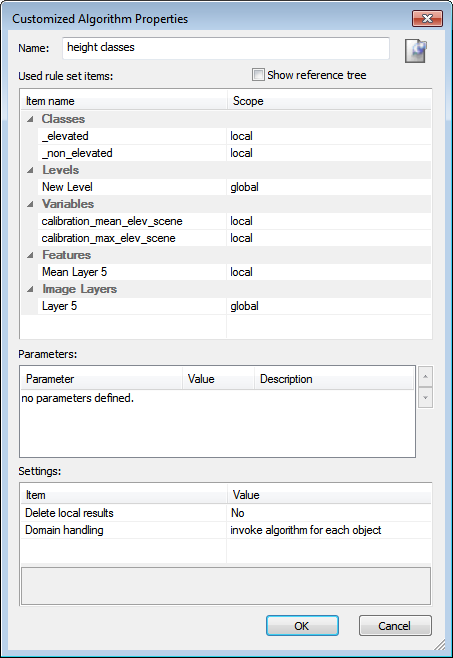
- To create a customized algorithm, go to the Process Tree window and select the parent process of the process sequence that you want to use as customized algorithm. Do one of the following:
- Right-click the parent process and select Create Customized Algorithm from the context menu.
- Select Process > Process Commands > Create Customized Algorithm from the main menu. The Customized Algorithms Properties dialog box opens.
- Assign a name to the customized algorithm
- The Used Rule Set Items are arranged in groups. To investigate their dependencies, select the Show Reference Tree checkbox
- You can modify the scope of the used rule set items. Select an item from the list, then click the dropdown arrow button. The following options are available:
- Global: The item is used globally. It is also available for other processes.
- Local: The item is used internally. Other processes outside this customized algorithm are unable to access it. All occurrences of the original global item in the process sequence are replaced by a local item with the same name.
- Parameter: The item is used as a parameter of the algorithm. This allows the assignment of a specific value within the Algorithm parameters of the Edit Process dialog box whenever this customized algorithm is used.
- If you define the scope of a used a rule set item as a parameter, it is listed in the Parameters section. Modifying the parameter name renames the rule set item accordingly. Furthermore, you can add a description for each parameter. When using the customized algorithm in the Edit Process dialog box, the description is displayed in the parameter description field if it is selected in the parameters list. For parameters based on scene variables, you can also specify a default value. This value is used to initialize a parameter when the customized algorithm is selected in the Edit Process dialog box.
- Configure the general properties of the customized algorithm in the Settings list:
- Delete Local Results specifies if local rule set items are deleted from the image object hierarchy when the customized algorithm terminates.
- If set to No, references from the image object hierarchy to local rule set objects are not automatically deleted. This will result in a faster execution time when the customized algorithm is called. Make sure that you clean up all references to local objects in the code of your customized algorithm to avoid references to local objects in the image object hierarchy.
- If set to Yes, all references from local image objects are automatically deleted after execution of the customized algorithm. This applies to classifications with local classes, local image object levels and local image object layers.
- Domain Handling specifies the handling of the selected domain by the calling process.
- Invoke algorithm for each object: The customized algorithm is called for each image object in the domain of the calling process. This setting is recommended for customized algorithms designed to be used with the execute domain.
- Pass domain from calling process as parameter: The customized algorithm is called only once from the calling process. The selected domain can be accessed by the special ‘from calling process’ domain within processes of the customized algorithm.
- Delete Local Results specifies if local rule set items are deleted from the image object hierarchy when the customized algorithm terminates.
- Confirm with OK. The processes of the customized algorithm are displayed on a separate Customized Algorithms tab of the Process Tree window.
- Customized algorithms can be selected at the bottom of the algorithm drop-down list box in the Edit Process dialog box. The local classes are displayed in explicit sections within the Class Hierarchy window whenever the customized algorithm is selected.
- The map pin symbol, at the top right of the dialog box, lets you add a comment to the customized algorithm. This comment will be visible in the Process Tree. It will also be visible in the Algorithm Description field of the Edit Process dialog, when the customized algorithm is selected in the algorithm drop-down box.
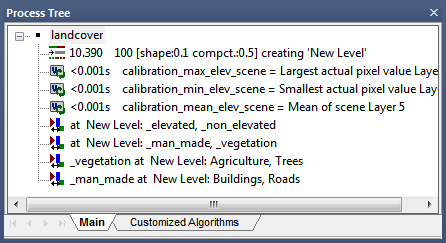
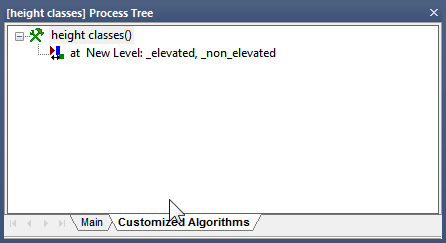
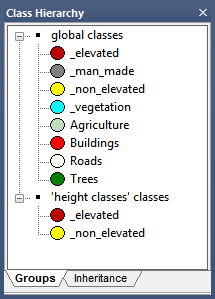
The local features and feature parameters are displayed in the feature tree of the Feature View window using the name of the customized algorithm, for example MyCustomizedAlgorithm.ArithmeticFeature1.
The local variables and variable parameters can be checked in the Manage Variables dialog box. They use the name of the customized algorithm as a prefix of their name, for example MyCustomizedAlgorithm.Pm_myVar.
The image object levels can be checked by in Edit Level Names dialog box. They use the name of the customized algorithm as a prefix of their name, for example MyCustomizedAlgorithm.New Level.
Using Customized Algorithms
Once you have created a customized algorithm, it displays in the Customized Algorithms tab of the Edit Process Tree window. The rule set items you specified as Parameter are displayed in parentheses following the algorithm’s name.
Customized algorithms are like any other algorithm; you use them in processes added to your rule set in the same way, and you can delete them in the same ways. They are grouped as Customized in the Algorithm drop-down list of the Edit Process dialog box.
You use them in processes added to your rule set in the same way, and you can delete them in the same ways. They are grouped as Customized in the Algorithm drop-down list of the Edit Process dialog box. If a customized algorithm contains parameters, you can set the values in the Edit Process dialog box.
Modifying a Customized Algorithm
You can edit existing customized algorithms like any other process sequence in the software. That is, you can modify all properties of the customized algorithm using the Customized Algorithm Properties dialog box. To modify a customized algorithm select it on the Customized Algorithms tab of the Process Tree window. Do one of the following to open the Customized Algorithm Properties dialog box:
- Double-click it
- Select Process > Process Commands > Edit Customized Algorithm from the main menu
- In the context menu, select Edit Customized Algorithm.
Executing a Customized Algorithm for Testing
You can execute a customized algorithm or its child processes like any other process sequence in the software.
Select the customized algorithm or one of its child processes in the Customized Algorithm tab, then select Execute. The selected process tree is executed. The application uses the current settings for all local variables during execution. You can modify the value of all local variables, including parameters, in the Manage Variables dialog box.
If you use the Pass domain from calling process as a parameter domain handling mode, you additionally have to specify the domain that should be used for manual execution. Select the customized algorithm and do one of the following:
- Select Process > Process Commands > Edit Process Domain for stepwise execution from the main menu
- Select Edit Process Domain for Stepwise Execution in the context menu
- The Edit Process Domain for dialog box opens. Specify the domain that you want to be used for the from calling process domain during stepwise execution
- The Domain of the customized algorithm must be set to ‘from calling process’.
Deleting a Customized Algorithm
To delete a customized algorithm, select it on the Customized Algorithms tab of the Process Tree window. Do one of the following:
- Select Delete from the context menu
- Select Process > Process Commands > Delete from the main menu
- Press Del on the keyboard.
The customized algorithm is removed from all processes of the rule set and is also deleted from the list of algorithms in the Edit Process dialog box.
Customized algorithms and all processes that use them are deleted without reconfirmation.
Using a Customized Algorithm in Another Rule Set
You can save a customized algorithm like any regular process, and then load it into another rule set.
- Right-click on an instance process of your customized algorithm and choose Save As from the context menu. The parameters of the exported process serve as default parameters for the customized algorithm.
- You may then load this algorithm to any rule set by selecting Load Rule Set from the context menu in the Process Tree window. An process using the customized algorithm appears at the end of your process tree. The customized algorithm itself is available in the Customized Algorithms tab.
- To add another process using the imported customized algorithm, you can to select it from the Algorithm drop-down list in the Edit Process dialog box.
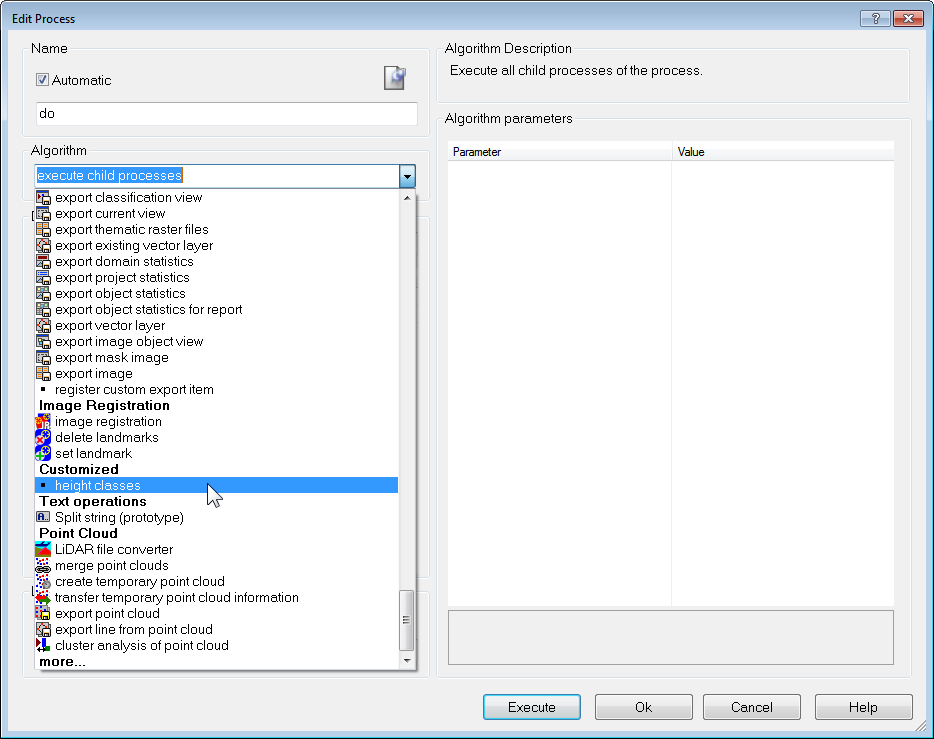
Maps
The Maps Concept
As explained in chapter one, a project can contain multiple maps. A map can:
- Contain image data independent of the image data in other project maps (a multi-project map)
- Contain a copy or subsets from another map (multi-scale map).
In contrast to workspace automation, maps cannot be analyzed in parallel; however, they allow you to transfer the image object hierarchy. This makes them valuable in the following use cases:
- Multi-scale and scene subset image analysis, where the results of one map can be passed on to any other multi-scale map
- Comparing analysis strategies on the same image data in parallel, enabling you to select the best results from each analysis and combine them into a final result
- Testing analysis strategies on different image data in parallel.
When working with maps, make sure that you always refer to the correct map in the domain. The first map is always called ‘main’. All child processes using a ‘From Parent’ map will use the map defined in a parent process. If there is none defined then the main map is used. The active map is the map that is currently displayed and activated in Map View – this setting is commonly used in Architect solutions. The domain Maps allows you to loop over all maps fulfilling the set conditions.
Be aware that increasing the number of maps requires more memory and the eCognition client may not be able to process a project if it has too many maps or too many large maps, in combination with a high number of image objects. Using workspace automation splits the memory load by creating multiple projects.
Adding a Map to a Project to Create Multi-Project Maps
Use cases that require different images to be loaded into one project, so-called multi-project maps, are commonly found:
- During rule set development, for testing rule sets on different image data
- During registration of two different images
There are two ways to create a multi-project:
- In the workspace, select multiple projects – with the status ‘created’ (not ‘edited’) – by holding down the Ctrl key, then right-click and choose Open from the context menu. The New Multi-Map Project Name dialog box opens. Enter the name of the new project and confirm; the new project is created and opens. The first scene will be displayed as the main map
- Open an existing project and go to File > Modify Open Project in the main menu. In the Modify Open Project dialog box, go to Maps > Add Map. Type a name for the new map in the Map box and assign the image and e.g. a subset for the new map. The new map is added to the Map drop-down list.
Copying a Map for Multi-Scale Analysis
Like workspace automation, a copy of a map can be used for multiscale image analysis – this can be done using the Copy Map algorithm. The most frequently used options are:
- Defining a subset of the selected map using a region variable
- Selecting a scale
- Setting a resampling method
- Copying all layers, selected image layers and thematic layers
- Copying the image object hierarchy of the source map
When defining the source map to be copied you can:
- Copy the complete map
- Copy a specific region (source region)
- Copy a defined image object
The third option creates a map that has the extent of a bounding box drawn around the image object. You can create copies of any map, and make copies of copies. eCognition Developer maps can be copied completely or 2D subsets can be created. Copying image layer or image objects to an already existing map overwrites it completely. This also applies to the main map, when it is used as target map. Therefore, image layers and thematic layers can be modified or deleted if the source map contains different image layers.
Use the Scale parameter to define the scale of the new map. Keep in mind that there are absolute and relative scale modes. For instance, using magnification creates a map with a set scale, for example 2x, with reference to the original project map. Using the Percent parameter, however, creates a map with a scale relative to the selected source map. When downsampling maps, make sure to stay above the minimum size (which is ). In case you cannot estimate the size of your image data, use a scale variable with a precalculated value in order to avoid inadequate map sizes.
Resampling is applied to the image data of the target map to be downsampled. The Resampling parameter allows you to choose between the following two methods:
- Fast resampling uses the pixel value of the pixel closest to the center of the source matrix to be resampled. In case the image has internal zoom pyramids, such as Mirax, then the pyramid image is used. Image layers copied with this method can be renamed
- Smooth resampling creates the new pixel value from the mean value of the source matrix starting with the upper left corner of the image layer. The time consumed by this algorithm is directly proportional to the size of the image data and the scale difference.
Displaying Maps
In order to display different maps in the Map View, switch between maps using the Select active map drop-down menu in the navigate toolb ar. To display several maps at once, use the Split commands available in the Window menu.
Synchronizing Maps
When working with multi-scale or multi-project maps, you will often want to transfer a segmentation result from one map to another. The Synchronize Map algorithm allows you to transfer an image object hierarchy using the following settings:
- The source map is defined in the domain. Select the image object level, map and, if necessary, classes, conditions and source region.
- With regard to the target map, set the map name, target region, level, class and condition. If you want to transfer the complete image object hierarchy, set the value to Yes.
Synchronize Map is most useful when transferring image objects of selected image object levels or regions. When synchronizing a level into the position of a super-level, then the relevant sub-objects are modified in order to maintain a correct image object hierarchy. Image layers and thematic layers are not altered when synchronizing maps.
Saving and Deleting Maps
Maps are automatically saved when saving the project. Maps are deleted using the Delete Map algorithm. You can delete each map individually using the domain Execute, or delete all maps with certain prefixes and defined conditions using the domain maps.
Working with Multiple Maps
Multi-Scale Image Analysis
Creating a downsampled map copy is useful if working on a large image data set when looking for regions of interest. Reducing the resolution of an image can improve performance when analyzing large projects. This multi-scale workflow may follow the following scheme.
- Create a downsampled map copy to perform an overview analysis
- Analyze this map copy to find regions of interest
- Synchronize the regions of interest as image objects back to the original map.
Likewise you can also create a scene subset in a higher scale from the downsampled map. For more information on scene subsets, refer to Workspace Automation.
One Map Per Object
In some use cases it makes sense to refine the segmentation and classification of individual objects. The following example provides a general workflow. It assumes that the objects of interest have been found in a previous step similar to the workflow explained in the previous section. In order to analyze each image object individually on a separate map do the following:
- In a parent process select an image object level domain at ‘new level’
- Add a Copy Map process, set the domain to ‘current image object’ and define your map parameters, including name and scale
- Use the Next process to set the new map as domain
- Using child processes below the process ‘on map temp’. Modify the image object and synchronize the results.
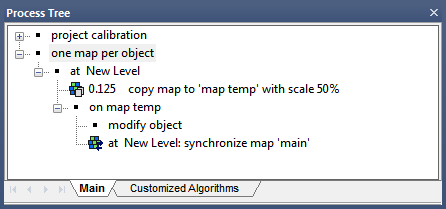
Workspace Automation
Overview
Detailed processing of high-resolution images can be time-consuming and sometimes impractical due to memory limitations. In addition, often only part of an image needs to be analyzed. Therefore, workspace automation enables you to automate user operations such as the manual selection of subsets that represent regions of interest. More importantly, multi-scale workflows – which integrate analysis of images at different magnifications and resolutions – can also be automated.
Within workspace automation, different kinds of scene copies, also referred to as sub-scenes, are available:
- Scene copy
- Scene subset
- Scene tiles
Sub-scenes let you work on parts of images or rescaled copies of scenes. Most use cases require nested approaches such as creating tiles of a number of subsets. After processing the sub-scenes, you can stitch the results back into the source scene to obtain a statistical summary of your scene.
In contrast to working with maps, workspace automation allows you to analyze sub-scenes concurrently, as each sub-scene is handled as an individual project in the workspace. Workspace automation can only be carried out in a workspace.
Scene Copy
A scene copy is a duplicate of a project with image layers and thematic layers, but without any results such as image objects, classes or variables. (If you want to transfer results to a scene copy, you might want to use maps. Otherwise you must first export a thematic layer describing the results.)
Scene copies are regular scene copies if they have been created at the same magnification or resolution as the original image (top scene). A rescaled scene copy is a copy of a scene at a higher or lower magnification or resolution.
To create a regular or rescaled scene copy, you can:
- Use the Create Scene Copy dialog (described in the next section) for manual creation
- Use the Create Scene Copy algorithm within a rule set; for details, see the eCognition Developer Reference Book.
The scene copy is created as a sub-scene below the project in the workspace.
Scene Subset
A scene subset is a project that contains only a subset area (region of interest) of the original scene. It contains all image layers and thematic layers and can be rescaled. Scene subsets used in workspace automation are created using the Create Scene Subset algorithm. Depending on the selected domain of the process, you can define the size and cutout position.
- Based on coordinates: If you select Execute in the Domain drop-down box, the given PIXEL coordinates of the source scene are used.
- Based on classified image objects: If you select an image object level in the Domain drop-down list, you can select classes of image objects. For each image object of the selected classes, a subset is created based on a rectangular cutout around the image object.
Neighboring image objects of the selected classes, which are located inside the cutout rectangle, are also copied to the scene subset. You can choose to exclude them from further processing by giving the parameter Exclude Other Image Objects a value of Yes. If Exclude Other Image Objects is set to Yes, any segmentation in the scene subset will only happen within the area of the image object used for defining the subset. Results are not transferred to scene subsets.
The scene subset is created as a sub-scene below the project in the workspace. Scene subsets can be created from any data set.
Scene Tiles
Sometimes, a complete map needs to be analyzed, but its large file size makes a straightforward segmentation very time-consuming or processor-intensive. In this case, creating scene tiles is a useful strategy. Creating scene tiles cuts the selected scene into equally sized pieces. To create a scene tile you can:
- Use the Create Tiles dialog (described in the next section) for manual creation
- Use the Create Scene Tiles algorithm within a rule set; for more details, see eCognition Developer > Reference Book.
Define the tile size for x and y; the minimum size is 100 pixels. Scene tiles cannot be rescaled and are created in the magnification or resolution of the selected scene. Each scene tile will be a sub-scene of the parent project in the workspace. Results are not included in the created tiles.
Scene tiles can be created from any data set. When tiling videos (time series), each frame is tiled individually.
Manually Creating Copies and Tiles
Creating a Copy with Scale
Manually created scene copies are added to the workspace as sub-scenes of the originating project. Image objects or other results are not copied into these scene copies.
- To create a copy of a scene at the same scale, or at another scale, select a project in the right-hand pane of the Workspace window.
- Right-click it and select Create Copy with Scale from the context menu. The Create Scene Copy with Scale dialog box opens.
- Edit the name of the subset. The default name is the same as the selected project name.
- You can select a different scale compared to that of the currently selected project; that way you can work on the scene copy at a different resolution. If you enter an invalid scale factor, it will be changed to the closest valid scale and displayed in the table. Reconfirm with OK. In the workspace window, a new project item appears within the folder corresponding to the scale (for example 100%).
- The current scale mode cannot be modified in this dialog box.
Click the Image View or Project Pixel View button on the View Settings toolbar to display the map at the original scene scale. Switch between the display of the map at the original scene scale (button activated) and the rescaled resolution (button released).
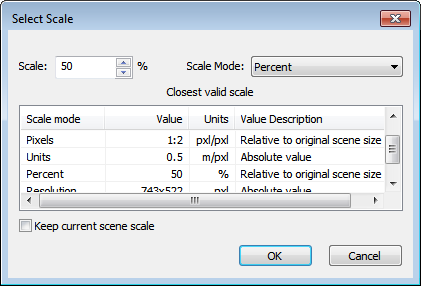
Creating Tiles
Manually created scene tiles are added into the workspace as sub-scenes of the originating project. Image objects or other results are not copied into these scene copies.
- To create scene tiles, right-click on a project in the right-hand pane of the Workspace window
- From the context menu, select Create Tiles on the context menu. The Create Tiles dialog box opens.
- Enter the tile size in x and y; the minimum tile size is 100 pixels. Confirm with OK and for each scene to be tiled, a new tiles folder will be created, containing the created tile projects named tile<number>.
You can analyze tile projects in the same way as regular projects by selecting single or multiple tiles or folders that contain tiles.
Manually Stitch Scene Subsets and Tiles
In the Workspace window, select a project with a scene from which you created tiles or subsets. These tiles must have already been analyzed and be in the ‘processed’ state. To open the Stitch Tile Results dialog box, select Analysis > Stitch Projects from the main menu or right-click in the workspace window.
The Job Scheduler field lets you specify the computer that is performing the analysis. It is set to http://localhost:8184 by default, which is the local machine. However, if you are running an eCognition Server over a network, you may need to change this field.
Click Load to load a ruleware file for image analysis – this can be a process (.dcp) or solution (.dax) file that contains a rule set to apply to the stitched projects.
For more details, see Submitting Batch Jobs to a Server.
Processing Sub-Scenes with Subroutines
The concept of workspace automation is realized by structuring rule sets into subroutines that contain algorithms for analyzing selected sub-scenes.
Workspace automation can only be done on an eCognition Server. Rule sets that include subroutines cannot be run in eCognition Developer in one go. For each subroutine, the according sub-scene must be opened.
A subroutine is a separate part of the rule set, cut off from the main process tree and applied to sub-scenes such as scene tiles. They are arranged in tabs of the Process Tree window. Subroutines organize processing steps of sub-scenes for automated processing. Structuring a rule set into subroutines allows you to focus or limit analysis tasks to regions of interest.

The general workflow of workspace automation is as follows:
- Create sub-scenes using one of the Create Scene algorithms
- Hand over the created sub-scenes to a subroutine using the Submit Scenes for Analysis algorithm. All sub-scenes are processed with the rule set part in the subroutine. Once all sub-scenes have been processed, post-processing steps – such as stitch back – are executed as defined in the Submit Scenes for Analysis algorithm.
- The rule set execution is continued with the next process following the Submit Scenes for Analysis algorithm.
A rule set with subroutines can be executed only on data loaded in a workspace. Processing a rule set containing workspace automation on an eCognition Server allows simultaneous analysis of the sub-scenes submitted to a subroutine. Each sub-scene will then be processed by one of the available engines.
Creating a Subroutine
To create a subroutine, right-click on either the main or subroutine tab in the Process Tree window and select Add New. The new tab can be renamed, deleted and duplicated. The procedure for adding processes is identical to using the main tab.
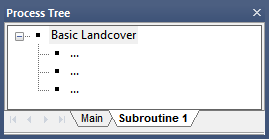
Executing a Subroutine
Developing and debugging open projects using a step-by-step execution of single processes is appropriate when working within a subroutine, but does not work across subroutines. To execute a subroutine in eCognition Developer, ensure the correct sub-scene is open, then switch to the subroutine tab and execute the processes.
When running a rule set on an eCognition Server, subroutines are automatically executed when they are called by the Submit Scenes for Analysis algorithm (for a more detailed explanation, consult the eCognition Developer Reference Book).
Editing Subroutines
Right-clicking a subroutine tab of the Process Tree window allows you to select common editing commands.

You can move a process, including all child processes, from one subroutine to another subroutine using copy and paste commands. Subroutines are saved together with the rule set; right-click in the Process Tree window and select Save Rule Set from the context menu.
Multi-Scale Workflows
The strategy behind analyzing large images using workspace automation depends on the properties of your image and the goal of your image analysis. Most likely, you will have one of the following use cases:
- Complete analysis of a large image, for example finding all the houses in a satellite image. In this case, an approach that creates tiles of the complete image and stitches them back together is the most appropriate
- A large image that contains small regions of interest requiring a detailed analysis, such as a tissue slide containing samples. In this use case, we recommend you create a small-scale copy and derive full-scale subsets of the regions of interests only.
To give you practical illustrations of structuring a rule set into subroutines, refer to the use cases in the next section, which include samples of rule set code. For detailed instructions, see the related instructional sections and the algorithm settings in the eCognition Developer Reference Book.
Tiling and Stitching
Tiling an image is useful when an analysis of the complete image is problematic. Tiling creates small copies of the image in sub-scenes below the original image. (For an example of a tiled top scene, see the figure below). Each square represents a scene tile.
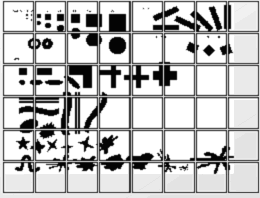
In order to put the individually analyzed tiles back together, stitching is required. Exemplary rule sets can be found in the eCognition User Community (e.g. User Community - Tiling and Stitching). A complete workflow and implementation in the Process Tree window is illustrated here:
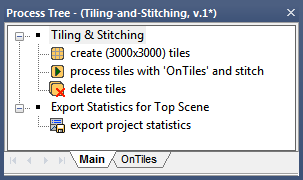
- Select the Create Scene Tile algorithm and define the tile size. When creating tiles, the following factors should be taken into account:
- The larger the tile, the longer the analysis takes; however, too many small tiles increases loading and saving times
- When stitching is requested, bear in mind that there are limitations for the number of objects over all the tiles, depending on the number of available image layers and thematic layers.
- Tiles are handed over to the subroutine analyzing the scene tiles by the Submit Scenes for Analysis algorithm.
- In the Type of Scenes field, select Tiles
- Set the Process Name to ‘Subroutine 1’
- Use Percent of Tiles to Submit if you want a random selection to be analyzed (for example, if you want a statistical overview)
- Set Stitching to Yes in order to stitch the analyzed scene tiles together in the top scene
- Setting Request Post-Processing to No will prevent further analysis of the stitched tiles, as an extra step after stitching
Each tile is now processed with the rule set part from Subroutine 1. After all tiles have been processed, stitching takes place and the complete image hierarchy, including object variables, is copied to the top scene.
- In case you want to remove the created tiles after stitching, use the Delete Scenes algorithm and select Type of Sub-Scenes: Tiles. (For a more detailed explanation, consult the Reference Book.)
- Finally, in this example, project statistics are exported based on the image objects of the top scene.
Only the main map of tile projects can be stitched together.
Create a Scene Subset
In this basic use case, a subroutine limits detailed analysis to subsets representing ROIs – this leads to faster processing.
Commonly, such subroutines are used at the beginning of rule sets and are part of the main process tree on the Main tab. Within the main process tree, you sequence processes in order to find ROIs against a background. Let us say that the intermediate results are multiple image objects of a class ‘no_background’, representing the regions of interest of your image analysis task.
While still editing in the main process tree, you can add a process applying the Create Scene Subset algorithm on image objects of the class ‘no_background’ in order to analyze ROIs only.
The subsets created must be sent to a subroutine for analysis. Add a process with the algorithm Submit Scenes for Analysis to the end of the main process tree; this executes a subroutine that defines the detailed image analysis processing on a separate tab.
Use Cases: Multi-Scale Image Analysis 1–3
Creating scene copies and scene subsets is useful if working on a large image data set with only a small region of interest. Scene copies are used to downscale the image data. Scene subsets are created from the region of interest at a preferred magnification or resolution. Reducing the resolution of an image can improve performance when analyzing large projects.
In eCognition Developer you can start an image analysis on a low-resolution copy of a map to identify structures and regions of interest. All further image analyses can then be done on higher-resolution scenes. For each region of interest, a new subset project of the scene is created at high resolution. The final detailed image analysis takes place on those subset scenes. This multi-scale workflow can follow the following scheme.
- Create a downsampled copy of the scene at a lower resolution to perform an overview analysis. This scene copy will become a new map in a new project of the workspace.
- Analyze the downsampled scene copy to find regions of interest. To allow a faster detailed image analysis, select regions of interest and create a scene subset of the regions of interest at a higher scale.
- In order to allow faster and concurrent processing, create tiles
- Stitch the tiles back together and copy the results to the scene subsets
- Stitch the scene subsets with their results back together
| Workflow | Subroutine | Key Algorithm | |
|---|---|---|---|
| 1 | Create a scene copy at lower magnification | Main | Create Scene Copy |
| 2 | Find regions of interest (ROIs) | Create rescaled subsets of ROIs | Common image analysis algorithms |
| 3 | Create subsets of ROIs at higher magnification | Create rescaled subsets of ROIs | Create Scene Subset |
| 4 | Tile subsets | Tiling and stitching of subsets | Create Scene Tiles |
| 5 | Detailed analysis of tiles | Detailed analysis of tiles | Several |
| 6 | Stitch tile results to subset results | Detailed analysis of tiles | Submit Scenes for Analysis |
| 7 | Merge subsets results back to main scene | Create rescaled subsets of ROIs | Submit Scenes for Analysis |
| 8 | Export results of main scene | Export results of main scene | Export Classification View |
This workflow could act as a prototype of an analysis automation of an image at different magnifications or resolutions. However, when developing rule sets with subroutines, you must create a specific sequence tailored to your image analysis problem.
Multi-Scale 1: Rescale a Scene Copy
Create a rescaled scene copy at a lower magnification or resolution and submit for processing to find regions of interest.
In this use case, you use a subroutine to rescale the image at a lower magnification or resolution before finding regions of interest (ROIs). In this way, you reduce the amount of image data that needs to be processed and your process consumes less time and performance. For the first process, use the Create Scene Copy algorithm.
With the second process – based on the Submit Scenes for Analysis algorithm – you submit the newly created scene copy to a new subroutine for finding ROIs at a lower scale.
When working with subroutines you can merge back selected results to the main scene. This enables you to reintegrate results into the complete image and export them together. To fulfill a prerequisite to merging results back to the main scene, set the Stitch Subscenes parameter to Yes in the Submit Scenes Analysis algorithm.

Multi-Scale 2: Create Rescaled Subset Copies of Regions of Interest
In this step, you use a subroutine to find regions of interest (ROIs) and classify them, in this example, as ‘ROI’.
Based on the image objects representing the ROIs, you create scene subsets of the ROIs. Using the Create Scene Subset algorithm, you can rescale them to a higher magnification or resolution. This scale will require more processing performance and time, but it also allows a more detailed analysis.
Finally, submit the newly created rescaled subset copies of regions of interest for further processing to the next subroutine. Use the Submit Scenes for Analysis algorithm for such connections of subroutines.
Create Rescaled Subsets of ROI Find Regions of Interest (ROI) ... ... ... ROI at ROI_Level: create subset 'ROI_Subset' with scale 40x process 'ROI_Subset*' subsets with 'Tiling+Stitching of Subsets' and stitch with 'Export Results of Main Scene'
Multi-Scale 3: Use Tiling and Stitching
Create tiles, submit for processing, and stitch the result tiles for post-processing. In this step, you create tiles using the Create Scene Tiles algorithm.
In this example, the Submit Scenes for Analysis algorithm subjects the tiles to time- and performance-consuming processing which, in our example, is a detailed image analysis at a higher scale. Generally, creating tiles before processing enables the distribution of the analysis processing on multiple instances of Analysis Engine software.
Here, following processing of the detailed analysis within a separate subroutine, the tile results are stitched and submitted for post-processing to the next subroutine. Stitching settings are done using the parameters of the Submit Scenes for Analysis algorithm.
Tiling+Stitching Subsets create (500x500) tiles process tiles with 'Detailed Analysis of Tiles' and stitch Detailed Analysis of Tiles Detailed Analysis ... ... ...
If you want to transfer result information from one sub-scene to another, you can do so by exporting the image objects to thematic layers and adding this thematic layer then to the new scene copy. Here, you either use the Export Vector Layer or the Export Thematic Raster Files algorithm to export a geocoded thematic layer. Add features to the thematic layer in order to have them available in the new scene copy.
After exporting a geocoded thematic layer for each subset copy, add the export item names of the exported thematic layers in the Additional Thematic Layers parameter of the Create Scene Tiles algorithm. The thematic layers are matched correctly to the scene tiles because they are geocoded.
Using the submit scenes for analysis algorithm, you finally submit the tiles for further processing to the subsequent subroutine. Here you can utilize the thematic layer information by using thematic attribute features or thematic layer operations algorithms.
Likewise, you can also pass parameter sets to new sub-scenes and use the variables from these parameter sets in your image analysis.
Getting Sub-Project Statistics in Nested Workspace Automation
Sub-scenes can be tiles, copies or subsets. You can export statistics from a sub-scene analysis for each scene, and collect and merge the statistical results of multiple files. The advantage is that you do not need to stitch the sub-scenes results for result operations concerning the main scene.
To do this, each sub-scene analysis must have had at least one project or domain statistic exported. All preceding sub-scene analysis, including export, must have been processed completely before the Read Subscene Statistics algorithm starts any result summary calculations. Result calculations can be performed:
- In the main process tree after the Submit Scenes to Analysis algorithm
- In a subroutine within a post-processing step of the Submit Scenes to Analysis algorithm.
After processing all sub-scenes, the algorithm reads the exported result statistics of the sub-scenes and performs a defined mathematical summary operation. The resulting value, representing the statistical results of the main scene, is stored as a variable. This variable can be used for further calculations or export operations concerning the main scene.
Object Links
About Image Object Links
Hierarchical image object levels allow you to derive statistical information about groups of image objects that relate to super-, neighbor- or sub-objects. In addition, you can derive statistical information from groups of objects that are linked to each other. Use cases that require you to link objects in different image areas without generating a common super-object include:
- Link objects between different timeframes of time series data, in order to calculate a moving distance or direction of an object in time
- Link-distributed cancer indications
- Linking a bridge to a street and a river at the same time.
The concept of creating and working with image object links is similar to analyzing hierarchical image objects, where an image object has ‘virtual’ links to its sub- or superobjects. Creating these object links allows you to virtually connect objects in different maps and areas of the image. In addition, object links are created with direction information that can distinguish between incoming and outgoing links, which is an important feature for object tracking.
Image Objects and their Relationships
Implementing Child Domains via the Execute Child Process Algorithm
Through the tutorials in earlier chapters, you will already have some familiarity with the idea of parent and child domains, which were used to organize processes in the Process Tree. In that example, a parent object was created which utilized the Execute Child Processes algorithm on the child processes beneath it.
The child processes within these parents typically defined algorithms at the image object level. However, depending on your selection, eCognition Developer can apply algorithms to other objects selected from the Domain.
- Current image object: The parent image object itself.
- Neighbor obj: The distance of neighbor objects to the parent image object. If distance is zero, this refers to image objects that have a common border with the parent and lie on the same image object level. If a value is specified, it refers to the distance between an object’s center of mass and the parent’s center of mass, up to that specified threshold
- Sub objects: Objects whose image area covers all or part of the parent’s image area and lie a specified number of image object levels below the parent’s image object level.
- Super objects: Objects whose image area covers some or all of the parent’s image area and lie a specified number of image object levels above the parent’s image object level. (Note that the child image object is on top here.)
Creating and Saving Image Object Links
Object Links are created using the Create links algorithm. Links may link objects on different hierarchical levels, different frames or on different maps. Therefore, an image object can have any number of object links to any other image object. A link belongs to the level of its source image object.
The direction of a link is always directed towards the target object, so is defined as an incoming link. The example in the figure below shows multiple time frames (T0 to T4). The object (red) in T2 has one incoming link and two outgoing links. In most use cases, multiple links are created in a row (defined as a path). If multiple links are connected to one another, the link direction is defined as:
- In: Only incoming links, entering directly
- Out: Only outgoing links, entering directly
- All: All links coming into and out of the selected object, including paths that change direction
The length of a path is described by a distance. Linked object features use the max. distance parameter as a condition. Using the example in the figure below, distances are counted as follows:
- T0 to T1: Distance is 0
- T0 to T2: Distance is 1
- T0 to T4: Distance is 3 (to both objects)
An object link is stored in a class, called the link class. These classes appear as normal classes in the class hierarchy and groups of links can be distinguished by their link classes. When creating links, the domain defines the source object and the candidate object parameters define the target objects. The target area is set with the Overlap Settings parameters.
Existing links are handled in this way:
- Splitting an object with m links into n fragments creates n objects, each linking in the same way as the original object. This will cause the generation of
new links (which are clones of the old ones)
- Copying an image object level will also copy the links
- Deleting an object deletes all links to or from this object
- Links are saved with the project.
When linking objects in different maps, it may be necessary to apply transformation parameters – an example is where two images of the same object are taken by different devices. You can specify a parameter set defining an affine transformation between the source and target domains of the form ax + b, where a is the transformation matrix and b is the translation vector.

Displaying Object Links
By default all object links of an image object are outlined when selecting the image object in the Map View. You can display a specific link class, link direction, or links within a maximal distance using the Edit Linked Object Visualization dialog. Access the dialog in the Menu: View – Display Mode - Edit Linked Object Visualization.
Deriving Object Link Statistics
For creating statistics about linked objects, eCognition Developer provides Linked Objects Features:
- Linked Objects Count – counts all objects that are linked to the selected object and that match the link class filter, link direction and max. distance settings.
- Statistics of Linked Objects – provides statistical operations such as Sum or Mean over a selected feature taking the set object link parameters into account.
- Link weight to PPO – computes the overlap area of two linked objects to each other.
Polygons and Skeletons
Polygons are vector objects that provide more detailed information for characterization of image objects based on shape. They are also needed to visualize and export image object outlines. Skeletons, which describe the inner structure of a polygon, help to describe an object’s shape more accurately.
Polygon and skeleton features are used to define class descriptions or refine segmentations. They are particularly suited to studying objects with edges and corners.
A number of shape features based on polygons and skeletons are available. These features are used in the same way as other features. They are available in the feature tree under Object Features > Geometry > Based on Polygons or Object Features > Geometry > Based on Skeletons.
Polygon and skeleton features may be hidden – to display them, go to View > Customize and reset the View toolbar.
Viewing Polygons
Polygons are available after the first segmentation of a map. To display polygons in the map view, click the Show/Hide Polygons button (if activated deactivate Show or Hide outlines button first). For further options, open View > Display Mode > Edit Highlight Colors.
If the polygons cannot be clearly distinguished due to a low zoom value, they are automatically deactivated in the display. In that case, choose a higher zoom value.
Viewing Skeletons
Skeletons are automatically generated in conjunction with polygons. To display skeletons, click the Show/Hide Skeletons button and select an object. You can change the skeleton color in the Edit Highlight Colors settings.
To view skeletons of multiple objects, draw a polygon or rectangle, using the Manual Editing toolbar to select the desired objects and activate the skeleton view.
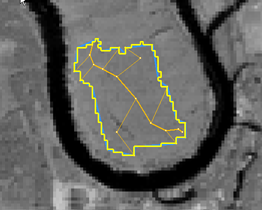
About Skeletons
Skeletons describe the inner structure of an object. By creating skeletons, the object’s shape can be described in a different way. To obtain skeletons, a Delaunay triangulation of the objects’ shape polygons is performed. The skeletons are then created by identifying the mid-points of the triangles and connecting them. To find skeleton branches, three types of triangles are created:
- End triangles (one-neighbor triangles) indicate end points of the skeleton A
- Connecting triangles (two-neighbor triangles) indicate a connection point B
- Branch triangles (three-neighbor triangles) indicate branch points of the skeleton C.
The main line of a skeleton is represented by the longest possible connection of branch points. Beginning with the main line, the connected lines then are ordered according to their types of connecting points.
The branch order is comparable to the stream order of a river network. Each branch obtains an appropriate order value; the main line always holds a value of 0 while the outmost branches have the highest values, depending on the objects’ complexity.
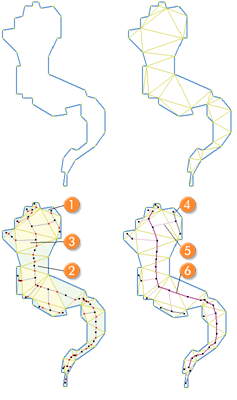
The right image shows a skeleton with the following branch order:
- 4: Branch order = 2.
- 5: Branch order = 1.
- 6: Branch order = 0 (main line).
Encrypting and Decrypting Rule Sets
Encrypting rule sets prevents others from reading and modifying them. To encrypt a rule set, first load it into the Process Tree window. Open the Process menu in the main menu and select Encrypt Rule Set to open the Encrypt Data dialog box. Enter the password that you will use to decrypt the rule set and confirm it.
The rule set will display only the parent process, with a padlock icon next to it. If you have more than one parent process at the top level, each of them will have a lock next to it. You will not be able to open the rule set to read or modify it, but you can append more processes to it and they can be encrypted separately, if you wish.
Decrypting a rule set is essentially the same process; first load it into the Process Tree window, then open the Process menu in the main menu bar and select Decrypt Rule Set to open the Decrypt Data dialog box. When you enter your password, the padlock icon will disappear and you will be able to read and modify the processes.
If the rule set is part of a project and you close the project without saving changes, the rule set will be decrypted again when you reopen the project. The License id field of the Encrypt Data dialog box is used to restrict use of the rule set to specific eCognition licensees. Simply leave it blank when you encrypt a rule set.
1 As with class-related features, the relations refer to the group hierarchy. This means if a relation refers to one class, it automatically refers to all its subclasses in the group hierarchy. (↑)
2 Customized features that are based on class-related features cannot be saved by using the Save Customized Features menu option. They must be saved with a rule set. (↑)
